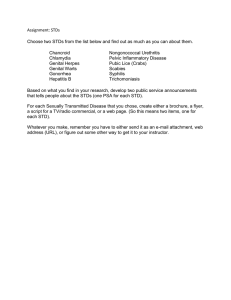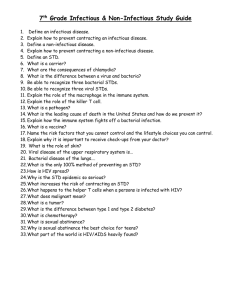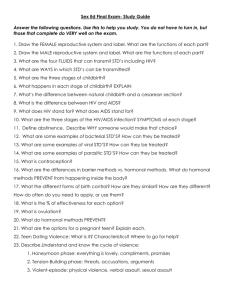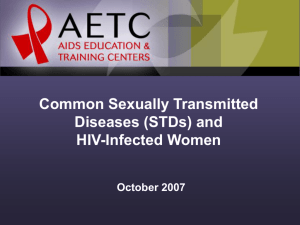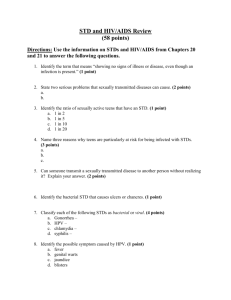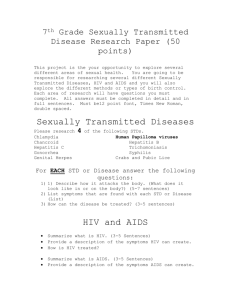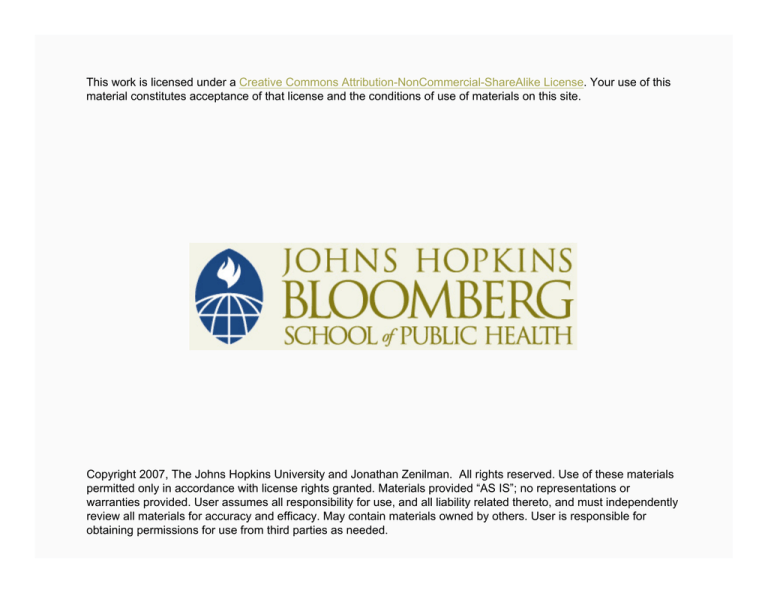
This work is licensed under a Creative Commons Attribution-NonCommercial-ShareAlike License. Your use of this
material constitutes acceptance of that license and the conditions of use of materials on this site.
Copyright 2007, The Johns Hopkins University and Jonathan Zenilman. All rights reserved. Use of these materials
permitted only in accordance with license rights granted. Materials provided “AS IS”; no representations or
warranties provided. User assumes all responsibility for use, and all liability related thereto, and must independently
review all materials for accuracy and efficacy. May contain materials owned by others. User is responsible for
obtaining permissions for use from third parties as needed.
STD Epidemiology
Jonathan Zenilman, MD
Johns Hopkins University
Jonathan Zenilman, MD
For the CDC he conceived, developed,
and implemented the National Gonococcal
Isolates Surveillance Program and wrote
the 1989 STD Treatment Guidelines
At Hopkins sine 1989, where he has developed an active
clinical and translational research program focusing on
STD epidemiology
Chief of clinical services at the Baltimore City Health
Department between 1992 and 1995 and senior medical
advisor at the U.S. Department of Health and Human
Services from 1995 to 1997
3
Section A
Background
Importance of Preventing and Controlling STDs
International health objective
High rates of complications and adverse health outcomes
High human and economic costs
STDs facilitate the transmission of HIV (Wasserheit,
1992)
Relationship to other co-morbidities such as substance
use and mental illness
5
Events/Outcomes: Costs and Morbidity of Sexual Behavior
Unintended pregnancy
LBW infants
Terminations
STD direct costs-medical (PID)
Long-term STD costs (ectopics, infertility)
Emotional and economic costs
Potentiated HIV Risk (3–6X)
6
Long After Kinsey, Only the Brave Study Sex
7
Condom Use at Last Sex (YRBS*) 1991–2001
*Youth Risk Behavior Surveillance System
8
Condom Use at Last Sex (GSS *)
*General Social Survey
Data Source: Anderson et al. (2003, October 1). J Acquir Immune Defic Syndr, 34, 2, 195–202.
9
Disease Rates
Total Population
=
Based Rate
Total cases of disease
Total population
Sexually active adults
at risk for GC
10
Disease Rates
Total Population
=
Based Rate
Total cases of disease
Total population
11
STI Incidence Factors
INDIVIDUAL BEHAVIOR
STI INCIDENCE
BIOLOGY OF ORGANISM
Inspired by Anne Johnson. (2005)
12
STI Incidence Factors
BEHAVIOR OF POPULATIONS
CONTROL PROGRAMS
ECOLOGY ORGANISM
Inspired by Anne Johnson. (2005)
SES and
Demographics
STI INCIDENCE
TIME
13
Structural Difference between Two Social Networks
14
Sexual Contacts among Homosexual Men with AIDS
15
Section B
Bacterial STDs and the Epidemiological Applications
Gonorrhea Rates
United States, 1970–2004, and the Healthy People 2010
target
Note: The Healthy People 2010 target for gonorrhea is 19.0 cases per 100,000 population.
Source: CDC Division of STD Prevention
17
Gonorrhea Rates by Race and Ethnicity
United States, 1981–2002, and the Healthy People 2010
objective
Rate (per 100,000 population)
2,500
White
Black
Hispanic
Asian/Pac Isl
Am Ind/AK Nat
2010 Objective
2,000
1,500
1,000
500
0
1981
83
85
87
Source: CDC Division of STD Prevention
89
91
93
95
97
99
2001
18
Gonorrhea—Rates by County: United States, 2002
Note: The Healthy People 2010 objective for
gonorrhea is 19.0 cases per 100,000 population
Source: CDC Division of STD Prevention
19
Reported Gonorrhea Rates by Year: 1995–2004
Reported Gonorrhea Rates by Year: 1995-2004 (Projection)
Health Promotion and Disease Prevention
Baltimore City Health Department
1200.0
1000.0
Rate per 100,000
800.0
600.0
Baltimore
US
400.0
200.0
0.0
1995
1996
1997
1998
1999
Source: Baltimore City Health Department, STD Surveillance Unit
July 2004
2000
2001
2002
2003
2004*
* Projected 2004 Rate
2003 and 2004 US Rates
20
Gonorrhea in Baltimore, 2003, by Gender and Location
Baltimore City Health Dept. STD Suveillance Unit
21
Gonorrhea Rate per 100,000 per Census Block Group
Gonorrhea rate per 100,000 per census block
group, 1994–1999, Baltimore City
Baltimore City Health Dept. STD Suveillance Unit
22
Chlamydia Rates by Sex: United States, 1984–2002
Rate (per 100,000 population)
500
400
300
Men
Women
200
100
0
1984
86
88
Source: CDC Division of STD Prevention
90
92
94
96
98
2000
02
23
Section C
Prevalent Chronic Viral Infections: Herpes Simplex
Prevalent Infections: The Control Challenge
Strategy based on prevalent data
Time trajectory often not known
Evaluation of interventions is methodologically difficult
Use of surrogate (e.g., behavioral) markers for evaluation
25
HSV-2 Seroprevalence: 1976–80 and 1988–94 (U.S.)
26
HSV-2 Seroprevalence
By age, race/ethnicity—NHANES III (1991)
27
HSV-2 Seroprevalence in the United States
Source: Fleming, P. (1997). N Engl J Med; CDC National Meeting. (2004).
28
Subclinical Viral Shedding
More than 90% of persons with genital HSV-2 shed virus
asymptomatically
Present 1–10% of asymptomatic days in persons who
have recurrent herpes due to HSV-2
Uncommon in HSV-1 genital infection
Frequency highest in first year after acquisition
Responsible for most transmission
Wald A NEJM 1995.
29
Section D
Epidemiology of Syphilis
Primary and Secondary Syphilis Rates: 1995–2004
Reported Primary and Secondary Syphilis rates by Year: 1995-2004 (Projection)
Health Promotion and Disease Prevention
Baltimore City Health Department
100.0
90.0
80.0
Rate per 100,000
70.0
60.0
50.0
Baltimore
US
40.0
30.0
20.0
10.0
0.0
1995
1996
1997
1998
1999
Source: Baltimore City Health Department, STD Surveillance Unit
July 2004
Baltimore City Health Dept. STD Suveillance Unit
2000
2001
2002
2003
2004*
* Projected 2004 Rate
2003 and 2004 US Rates
31
Primary and Secondary Syphilis Rates, United States
Primary and Secondary Syphilis Rates, United States,
1970–2004, and the Healthy People 2010 target
Rate (per 100,000 population)
25
P&S Syphilis
2010 Target
20
15
10
5
0
1970
73
76
79
82
85
88
91
94
97
2000
03
Note: The Healthy People 2010 target for P&S syphilis is 0.2 case per 100,000 population.
Source: CDC Division of STD Prevention
32
Syphilis Epidemiology Reflects Social Trends
1940s–1970s
− Poverty in the South and minority communities; CSWs
1975–1981
− Gay liberation movement
1981–1989
− AIDS epidemic
1988–1995
− Crack cocaine epidemic
1997–2005
− Syphilis elimination campaign
− Resurgence in homosexual men
33
Baltimore City Reported Early Syphilis, 2003
34
Male-to-Female Ratio, 2004
Source: CDC Division of STD Prevention
35
Section E
Reproductive Rate Equation
Simple but Useful Equation
Ro = ß c D
Reproductive rate
Probability of transmission
Number of sexual contacts
Duration of infectiousness
Source: Anderson and May. (1992).
37
Duration of Infection—Interventions
Ro = ßcD Duration of infection—interventions
− Reduction of d = reduction of asymptomatic pool
− Disease screening programs
− Partner notification and presumptive treatment
− Increased health care access
− Treatment guidelines
38
Transmission Efficiency—Interventions
R = ßcd Transmission efficiency—interventions
− Condom use and barrier methods
− Microbicides
− Hormonal contraceptives(?)
− Circumcision(?)
− Antiviral therapy(?)
X “Doc, now that my viral load is zero, do I still have
to use a condom?…Can I get a prescription for
Viagra?…”
39
Section F
HIV-STD Interactions
STDs As Cofactors in HIV Transmission
STDs increase HIV transmission
− Ï may influence HIV replication
− Ï viral load in genital secretions (ex: HSV-2
associated with higher HIV levels in plasma and in
genital secretions)
STDs increase susceptibility to HIV
− Disrupt mucosal barrier
− Ï number of receptor cells in genital tract
− Ï receptors expressed per cell
41
Importance of Acute HIV Infection in Transmissibility
42
Increased STDs in Gay Men
Trend observed since 1999
Behavioral relapse and increased disease rates
High proportion HIV-positive in syphilis epidemics
Trend observed in U.S. and Western Europe
43

